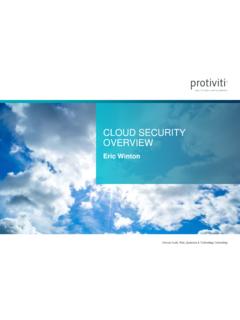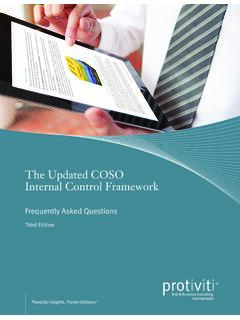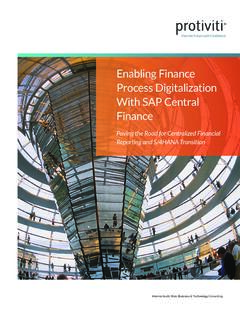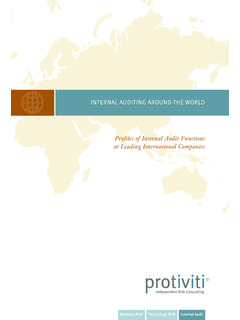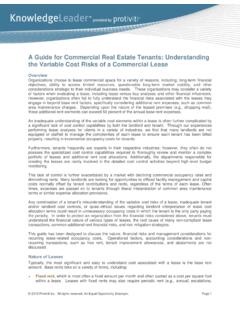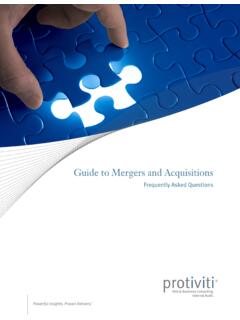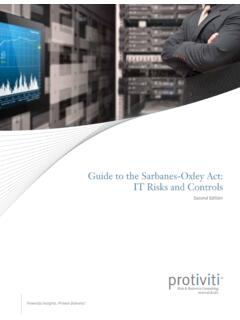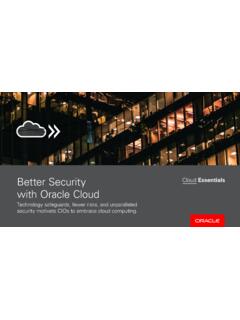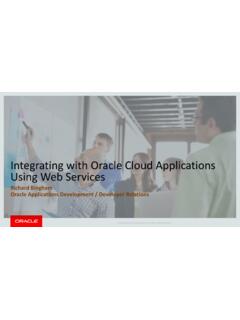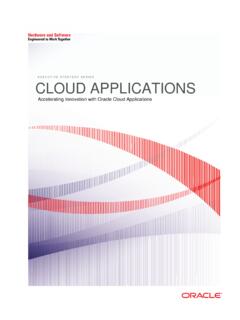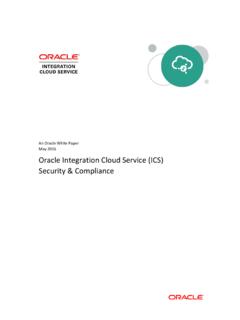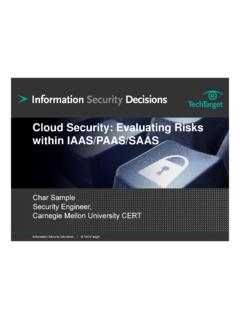Transcription of Oracle Security in the Cloud - Protiviti
1 Protiviti Oracle Security IN THE Cloud | COracle Security in the CloudA step-by-step approach to building strong Security architecture during Oracle ERP Cloud implementation and redesign projects Executive SummaryOrganizations are becoming more accepting of moving their key business applications to the Cloud , including their enterprise resource planning (ERP) systems. For companies looking to move to Oracle ERP Cloud , the advantages are many high scalability, consistent processes, real-time financial reporting and, not the least of all, cost savings from a hosted solution. Focusing on these benefits, however, should not obscure the need for a strong application Security design aimed to deter fraud and ensure that transactions performed in the Cloud are appropriate and authorized.
2 As auditors and the Public Company Accounting Oversight Board (PCAOB) continue to increase scrutiny of Segregation of Duties (SoD), it is important that organizations planning to implement Oracle ERP Cloud include a strong Security design within their requirements and project this white paper, we discuss the steps to achieve a secure Cloud system and avoid some of the common pitfalls in the Oracle Security IN THE Cloud | 1 INTRODUCTIONOver the past few years, Oracle has been shifting its software solutions portfolio to the Cloud to allow organizations to focus on business operations, with less time spent on back-end management of the supporting applications and infrastructure. As a result, organizations are increasingly transitioning off the standard on-premise, internally managed technologies in favor of a model that migrates key financial applications onto Oracle s Cloud infrastructure stack, which requires only a browser and an internet connection to idea of the Cloud has existed since the 1960s but has become more popular in recent years as computer processing power and bandwidth have made Cloud -based services more accessible.
3 Cloud computing leverages shared, elastic resources that can be delivered to users through self-service web technologies. This allows companies to use only what they need instead of purchasing resources and creating redundancies within their own data board members and chief executives are becoming better educated about Cloud capabilities and the potential cost savings, and chief information officers (CIOs) are increasingly asked to have a strategy for moving resources to the Cloud . This strategy may include data center services, email, VOIP and phone services, Microsoft Office products, and customer resource management (CRM) and enterprise resource planning (ERP) more organizations begin developing their ERP Cloud strategy, a number of considerations will drive executive decision-making, including compliance requirements and the impact that a Cloud solution will have on the organization s internal control structure.
4 Most notably, management will have to be proactive in planning for application-specific Security to support strong SoD and appropriate sensitive access levels. Leading practices indicate that access should be granted based on users job duties as well as management s risk tolerance for performing conflicting functions ( Create a Supplier and Issue Payment to a Supplier, for example).A well thought-out and implemented ERP Security design is the foundation for how the company s employees will interact with the application for years to come, allowing them to appropriately enter business transactions and interpret information used to manage the business. An effective design also scales with the growth of the organization without creating unexpected Security that do not maintain consistency with a well-designed Security model may face challenges during upgrades, acquisitions, employee hiring or termination, and other changes to the business.
5 Consequences of a poorly executed Security design include, but are not limited to: Errors stemming from entries by unauthorized personnel Unauthorized visibility into corporate information Fraudulent manipulation of financial information Theft of assets Inefficient access provisioning Regulatory and compliance issuesIn the sections below, we explain key concepts and provide recommendations to achieve a robust Security model and avoid these | Oracle Security IN THE Cloud PROTIVITITHE Oracle Cloud ERP Security MODELThe Security model within Oracle ERP Cloud is very different from that of traditional Oracle E-Business Suite (EBS) versions. Oracle has replaced the responsibility and menu containers with a role-based model that allows for a more robust and scalable approach to user administration.
6 The application Security architecture consists of six main components, discussed in detail below: 1. Privileges2. Duty roles3. Job roles4. Data Security policies5. Data roles6. Provisioning rules Privileges are an attribute of duty roles. The privileges assigned to a duty role determine what functionality a user is able to access on his or her screen all the available buttons, tabs, editable fields and reports capable of being generated by a particular user. Privileges are the old Function concept within Oracle EBS. Privileges are very specific to the capabilities within a form or menu for example, Create Payables Invoice, Validate Payables Invoice, or Initiate Payables Invoice Approval task roles are made up of different privileges within Oracle ERP Cloud .
7 The duty role is a collection of privileges aggregated to perform specific actions; typically, they are very specific task-based activities within the business process. An example of a duty role is Payables Invoice Creation Duty. The collection of privileges within this duty role would enable one to create and update an invoice, including through mass updates, updates through uploads, or direct modifications within the invoice form. The duty roles are the fundamental building blocks of Oracle ERP Cloud and are assigned directly to job roles. They are not assigned directly to a roles, which should represent specific jobs or positions within an organization, are a collection of duty roles that allow a person to perform specific job functions.
8 For example, the job role AP Clerk would allow the user to perform those functions an accounts payable clerk should be able to complete as part of his or her job requirements. The job role can be assigned directly to the RulesRole-Based Access Control (RBAC)Data RolesJob RoleDuty RoleData Security PolicyPrivilegeUserPROTIVITI Oracle Security IN THE Cloud | 3 Key Point: The key to taking a proactive Security approach is establishing strong policies governing Security design, and a solid foundation of job roles that are Security policies define on which data sets a user can perform his or her job. For example, the data role AP Clerk would allow the user to perform all the functions of the job role AP Clerk within the operating unit Data roles should be established according to the structure of the enterprise.
9 In Oracle EBS, data Security was managed through Profile Options, and access was granted based on Ledgers, Operating Units and Inventory Organizations. This data model still applies, but instead of assigning data access to a responsibility, the data access is restricted through data Security policies. The combination of job role and a data Security policy creates the data role that is assigned to the user. Key Point: Data roles inherit job roles that give them access to specific functionalities (through duty roles) and provide access to specific data sets on which to perform those functionalities. It is recommended that users are provisioned through data roles and not job roles should be created based on the various transactional needs of the organization and should consider the business units, warehouses, distribution centers and shared services that will be supporting each transaction.
10 Management should take data integrity into account when designing and assigning the data roles by restricting data access to the business units in which the ERP users rules are the rules that define how access will be granted to users. They ensure that the integrity of the Oracle Security model is maintained, by laying down specific processes for maintaining user access requests. We discuss provisioning rules in more detail in Steps 4 and 5 in the next Security WITHIN Oracle ERP CLOUDIt is important that organizations take a proactive approach to designing their Security models. Security requirements should be built into the blueprinting phase of the implementation to ensure that appropriate SoD is considered before the processes are implemented.
